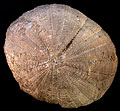The Echinoid Directory
Eurypneustes Duncan & Sladen, 1882, p. 45
[?Aeolopneustes Duncan & Sladen, 1882, p. 47, type species Aeolopneustes delorioli Duncan & Sladen, 1882 ]
| Diagnostic Features |
|
|---|---|
| Distribution | Latest Palaeocene - Lower Eocene, Pakistan. |
| Name gender | feminine |
| Type | Eurypneustes grandis Duncan & Sladen, 1882, p. 46, by original designation. Holotype: Geological Survey of India 2504. |
| Species Included |
|
| Classification and/or Status |
|
| Remarks |
|




